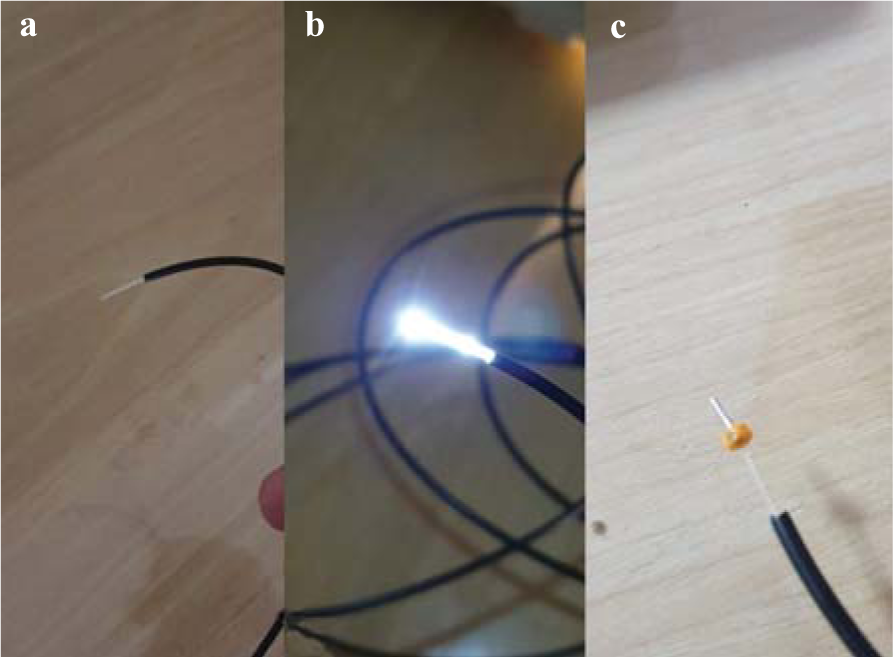Translate this page into:
Do-it-yourself chandelier illumination
[To cite: Venkatesh P, Bhayana AA, Azad SV. Do-it-yourself chandelier illumination. Natl Med J India 2024;37:398. DOI: 10.25259/NMJI_1030_2022]
During pars plana vitrectomy, bimanual manoeuvres could be invaluable in some complicated surgeries, e.g. dissection of diffuse and firmly adherent membranes in proliferative retinopathies; removal of deeply impacted retained intraocular foreign body and often in the management of giant retinal tear-associated retinal detachment. Visualization using chandelier endo-illumination (CE) is a boon during these bimanual interventions.1,2 CE is also critical to performing surgeries such as endo-illumination-assisted scleral buckling surgery and obtaining intraocular tissue samples by fine-needle aspiration biopsy. However, a chandelier light source may not be easily accessible in resource-constrained low- and middle-income countries, due to the additional cost of about US$100. To overcome this limitation, we devised a do-it-yourself (DIY) method to create a‘bimanual light source buddy’. We used a routine 27-gauge vitrectomy fibreoptic illumination probe (Constellation® vision system, ALCON) (which is discarded after surgery) and cut off its main handpiece using a wire cutter. Then, a small segment (about 4 mm) of the overlying sleeve, that encases the fibreoptic, was teased away using the wire cutter (Fig. 1a). The fibreoptic that was so exposed (Fig. 1b) inserted easily into a normal 23-gauge vitrectomy cannula (Fig. 1c). An improvised DIY chandelier source was created in an office setting. After adequate sterilization, it was tested during actual vitreous surgery and found to provide adequate visualization. Our innovation is a modification of an already in-use US Food and Drugs Administration approved endo-illumination system for vitrectomy and is hence biologically safe.3–5 It does not cause thermal injury at the application site as it is physically isolated from biological tissue with a 23-gauge cannula, into which it fits snugly. This provides the same stability as is provided by the original self-retaining chandelier light source.

- (a) Fibreoptic with overlying sleeve removed; (b) illumination tested; (c) insertion into cannula
References
- Bimanual 25-gauge chandelier technique for direct perfluorocarbon liquid-silicone oil exchange in retinal detachments associated with giant retinal tear. Indian J Ophthalmol. 2018;66:1849-51.
- [CrossRef] [PubMed] [Google Scholar]
- Trimanual vitrectomy for severe proliferative diabetic retinopathy. Int Ophthalmol. 2021;41:1717-27.
- [CrossRef] [PubMed] [Google Scholar]
- Silicone oil in vitreoretinal surgery. Dordrecht. Netherlands: Martinus Nijhoff/Dr. W. Junk Publishers;
- [Google Scholar]
- Grössere Sklerotomien für den Einsatz des multiportalen Illuminations systems erhöhen nicht das Komplikationsrisiko einer Vitrektomie [Larger sclerotomies for use of the multiport illumination system do not increase the complication risk of vitrectomy] Klin Monbl Augenheilkd. 1995;206:78-82.
- [CrossRef] [PubMed] [Google Scholar]
- Twin lights: A new chandelier illumination for bimanual surgery. Retina. 2003;23:893-4.
- [CrossRef] [PubMed] [Google Scholar]




